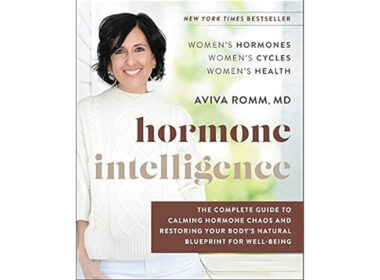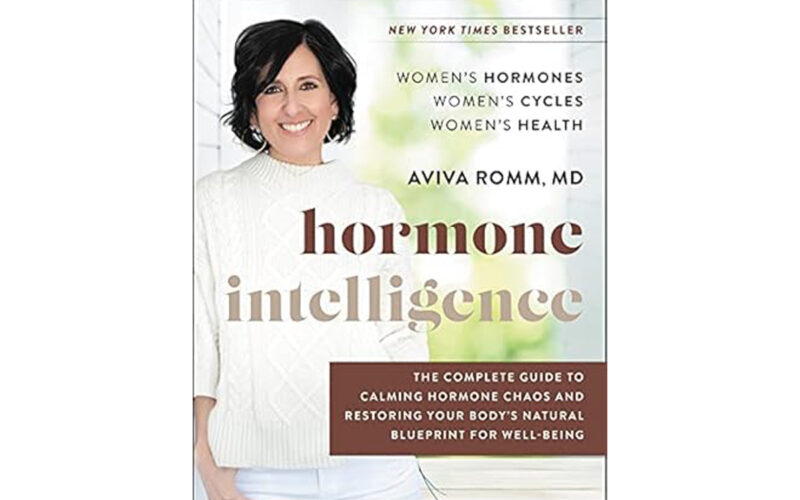What if your period problems, mood swings, and fatigue weren’t just “normal” parts of being a woman, but signals that your body is asking for support? In Hormone Intelligence, Dr. Aviva Romm offers a powerful reframe of women’s hormonal health, blending science, storytelling, and holistic wisdom to help you decode what your body is really telling you.
As a midwife, herbalist, and Yale-trained MD, Romm offers readers an unusual mix of empathy and expertise, guiding readers through everything from painful periods to perimenopause with clarity and compassion.
In this review, we dive into this book’s strengths and limitations, and whether you should buy, borrow, or skip Hormone Intelligence.
Dr. Aviva Romm isn’t your average health expert—her varied expertise means she truly gets the complexity of women’s hormonal health. Before she ever set foot in medical school, she spent years supporting women through birth, burnout, and everything in between. Her experience shows in the way she writes: with empathy, deep knowledge, and a refreshing lack of judgment. She understands that hormones don’t exist in a vacuum—they’re affected by stress, sleep, diet, trauma, and the pace of modern life.
Dr. Romm brings the scientific rigor of conventional medicine together with the whole-person lens of integrative care. She’s board-certified in family medicine and specializes in women’s health, and she’s spent decades studying how hormonal imbalances show up in real women’s lives. If you’ve ever felt brushed off by a doctor or frustrated by vague wellness advice, you’ll likely find Romm’s approach both grounding and empowering.
If you’ve ever felt brushed off by a doctor or frustrated by vague wellness advice, you’ll likely find Romm’s approach both grounding and empowering.
¿Cuál es el público destinatario de Hormone Intelligence?
This book is written for anyone with hormonal or gynecological concerns, particularly the women who have “been searching online for answers, perhaps even changing [their] diet, taking supplements,” and more (p. 1). Dr. Romm is writing specifically to women who are “experiencing a hormone imbalance or gynecologic condition that’s somewhere along the spectrum of annoying and troublesome to severe and debilitating” (p. 2).
¿Cuáles son las principales áreas de contenido de Hormone Intelligence?
Part one: Honing your ‘hormone intelligence’
Part one begins with a broad overview of the female hormones, and not just estrogen and progesterone. Dr. Romm discusses cortisol, thyroid hormones, and melatonin, among others. She presents a concept she calls “hormone intelligence,” and explains how trouble with your hormones could result in various reproductive health problems—from period pain to infertility.
She defines hormone intelligence as understanding your body’s blueprint to healthy hormones, monthly cycles, and life cycles (p. 27). When you understand how your body, especially your reproductive system, is supposed to work, you can decode what it might be trying to tell you when things aren’t going according to the blueprint. She says this intelligence is similar to a “cycle sense,” a term which refers to becoming familiar with what is normal and abnormal for your particular body and cycles. Romm recommends cycle charting and fertility awareness as ways to understand your normal hormone patterns (and as alternatives to the Pill later in the book).
When you understand how your body, especially your reproductive system, is supposed to work, you can decode what it might be trying to tell you when things aren’t going according to the blueprint.
She then has a chapter in which readers go through a lengthy list of symptoms and can match them up with conditions such as endometriosis, ovulatory insufficiency, or high estrogen. Romm covers these symptoms in some detail, including basic physiology and why each one impacts your overall health.
Part two: addressing hormonal concerns with lifestyle changes
Part two of the book consists of six chapters explaining Dr. Romm’s 6-week plan for resetting your hormones—a goal which she talks about measuring somewhat subjectively by how you feel after completing the protocol. This is the Hormone Intelligence Plan. The plan covers what foods to eat, how to reduce stress (both mental and physical), sleep and your circadian rhythm, the microbioma intestinal y related dysfunctions, toxic load (which she refers to as “body burden,” or the amount of “environmental chemicals, heavy metals, and other toxins any of us has stored in our body,” p.206-207), and then natural means of improving ovarian health (which will be of interest to the 873,000 women who searching ‘pcos’ online every month!).
Part three: advanced protocols
Part three has chapters with “advanced protocols” focusing more specifically on women’s health issues including premenstrual syndrome (PMS), polycystic ovary syndrome (PCOS), endometriosis, fertility, uterine fibroids, sexual health, and perimenopause. These advanced protocols contain specific food and herbal supplement recommendations that could alleviate symptoms after a reader has implemented the foundational 6-week plan.
Finally, the book includes a section called The Hormone Intelligence Kitchen which has recipes utilizing the healthy foods and herbal supplements recommended in earlier chapters.
Puntos fuertes de Hormone Intelligence
It feels like you’re finally being heard
One of the book’s greatest strengths is its validating, compassionate tone. Dr. Romm doesn’t dismiss symptoms as “just stress” or something to push through. Instead, she acknowledges the very real frustration many women face when their health concerns are ignored or minimized. In fact, the introduction is titled “You are not broken.” For readers who’ve felt dismissed by conventional medicine, this book can feel like a breath of fresh air—someone is finally listening.
There are sections on all the common women’s health issues
Whether you’re dealing with painful periods, perimenopause, fertility struggles, or general burnout, the book is structured to help you find relevant sections without needing to read cover to cover. That flexibility is a huge plus, especially for busy women who may be juggling work, family, and their own health all at once.
Hormone Intelligence blends conventional medicine with a functional nutrition approach
Dr. Romm has experience as a board-certified physician, an herbalist, and a midwife. As such, she brings a unique perspective to women’s health issues. She would be a great physician to have on your care team, and she tries to make her wisdom accessible to more readers through her book. I’m sure many women can relate to feeling ignored or dismissed by a conventional medical professional, or being told to “just take birth control” to fix hormone issues or period problems.
Dr. Romm acknowledges this and provides a deeper look into what could be causing your problems. She asserts there is a root cause—it’s just a matter of finding it and correcting it. She also treats alternative medicine approaches (like acupuncture, herbal remedies, and diet) as serious treatment options, rather than relying solely on prescription or over-the-counter drug solutions.
Limitaciones o puntos ciegos
“One study says…”
Dr. Romm references many studies. Unfortunately, the references for these are no included in her book. This is one of my biggest criticisms of her work. While she does include a link to her website providing a full reference list, it is not easy to find which specific reference she refers to in a particular chapter section.
Furthermore, presenting study statistics without context frequently makes for an overall fear-inducing tone. For example, in Chapter 6, she discusses switching to a Mediterranean-like diet for optimal hormone health. She shares one study that “found that for every 2% increase in calories consumed in the form of trans fats (a matter of a couple of tablespoons) in the daily diet, ovulatory infertility increased by more than 70%” (p. 103).
Without any context about the study participants (because, remember, the reference is hard to find), a woman might think that the bag of chips or the burger she ate could be causing her infertility. These days, you can find a study on Pubmed for just about anything, but that doesn’t mean every study is well-designed, or that the results are applicable to the general population.
Emphasis on self-diagnosis and self-prescribing
This book is all about taking charge of your own health. what about medical conditions that need medical care? Readers with more complex conditions (like PCOS, endometriosis, or autoimmune diseases) might need more guidance on where holistic care ends and medical intervention begins, or how both approaches should be blended or pursued simultaneously. In fact, spending time sólo following her hormone reset plan could potentially delay pursuing necessary medical care.
Additionally, Romm never really defines what “success” looks like in her program—but that’s because it’s entirely individual. How will you know your diet changes are “working”? You’ll feel less fatigued. How will you know you’ve successfully fixed your stress-hormone connection? You’ll feel “inner peace, better relationships, a healthier, more vital body and mind” (p. 158). How will you know you’ve optimized your gut-hormone connection? Your PMS symptoms or fertility might improve. You get the picture.
While many of Romm’s recommendations are excellent advice for a healthy female, and likely will move the needle on some symptoms, what about the women whose symptoms don’t improve? Romm doesn’t discredit medical professionals, but her advice could benefit from a “both/and” approach—both trying some healthy diet changes and stress reduction, but ensuring you have a strong medical team to support you in any complex conditions.
Blanket recommendations of inadequately tested herbal remedies
Some herbs Romm recommends—like chasteberry, ashwagandha, or black cohosh—can interact with prescription medications, including hormonal birth control, thyroid hormones, or antidepressants. They can also have side effects on their own. For example, some adaptogens may overstimulate the nervous system or disrupt sleep in certain individuals. Without professional guidance, unsuspecting readers could be blindsided by medication-herbal or herbal-herbal interactions and/or adverse responses.
There’s a growing assumption in wellness culture that natural remedies are inherently safer than pharmaceuticals, but that’s not always true. Herbs vary widely in potency and purity, especially when purchased from non-reputable sources. And while Romm generally provides responsible guidance, readers may still misunderstand dosage, timing, or contraindications if they don’t consult a healthcare professional who knows their personal health history. Furthermore, the effectiveness and tolerability of herbal solutions can be very individualized; for this reason, blanket recommendations may be unhelpful.
Of particular note, this book does no focus on or really even discuss pregnant or breastfeeding women, and while she claims most of the remedies are pregnancy and breastfeeding safe, I wish she had recommended consulting with a doctor, lactation specialist, and/or the LactMed database.
Dr. Romm makes a noticeable effort to be practical and approachable to the average woman. However, if we consider the “average woman” one who wants a solution to follow without doing additional research, I would actually say her suggestions are no practical. Let me explain.
There is a danger in reading a book attempting to diagnose hormone problems from afar y provide (potentially untested) herbal and “natural” solutions without fully understanding female physiology and hormones—what’s slightly out-of-whack and what’s the sign of a deeper medical condition like endometriosis. Rather than the average woman, the author’s suggestions may be most practical for a woman who is working closely with a medical professional y is skilled at interpreting medical signs, symptoms, results, and scientific data. This book could also be a good read for allied health professionals, or those with a health background but maybe not specifically women’s health expertise.
Rather than the average woman, the author’s suggestions may be most practical for a woman who is working closely with a medical professional y is skilled at interpreting medical signs, symptoms, results, and scientific data.
El veredicto: Comprar, tomar prestado o saltárselo Hormone Intelligence ¿Todos juntos?
Natural Womanhood readers may be best served by borrowing Hormone Intelligence. After all, most of the information in the first part of the book will be a review to the avid NW reader.
En Hormone Intelligence offers valuable tools and education, it’s not a replacement for personalized, professional medical care. For example, the 6-week program to “reset” your hormones may be best undertaken in conjunction con a physician, not by the average solo woman. Romm herself emphasizes the importance of professional medical care, but at the same time, her recommendations can seem as if they’re encouraging a DIY approach to your healthcare.
It’s important for readers to remember that just because something worked for someone else—or sounds like a “natural” fix—doesn’t mean it’s right or safe for your body. Instead of trying to DIY your health, your time and energy may be best spent finding a trusted medical professional who will listen to your concerns. My ultimate recommendation is to borrow this book, and then share what you’ve learned with him or her and make a plan for your health together.






